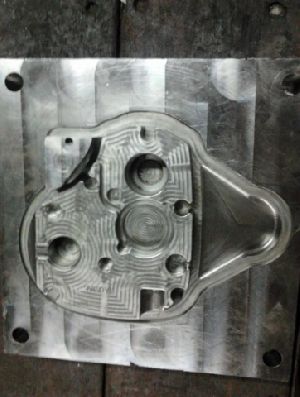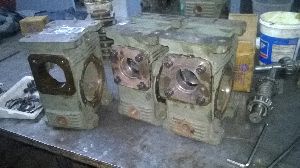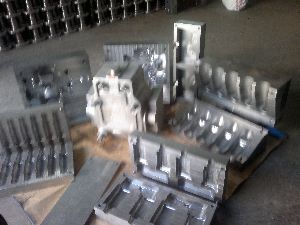
shell moulding dies
1 Piece(s) (MOQ)
The pattern, a metal piece in the shape of the desired part, is reused to form multiple shell moulds. A reusable pattern allows for higher production rates, while the disposable moulds enable complex geometries to be cast. Shell mould casting requires the use of a metal pattern, oven, sand-resin mixture, dump box, and molten metal. Shell mould casting allows the use of both ferrous and non-ferrous metals, most commonly using cast iron, carbon steel, alloy steel, stainless steel, aluminium alloys, and copper alloys. Typical parts are small-to-medium in size and require high accuracy, such as gear housings, cylinder heads, connecting rods, and lever arms.
...more
Rubber Moulding Dies
1 Piece(s) (MOQ)
Rubber moulding is a moulding process that produces a useable rubber product. Rubber products are made from uncured rubber or elastomers. An elastomer is any material with sufficient resilience or memory for returning to its original shape in response to pressure or distortions.
...more
Pressure Die Casting Dies
1 Piece(s) (MOQ)
The pattern, a metal piece in the shape of the desired part, is reused to form multiple shell moulds. A reusable pattern allows for higher production rates, while the disposable moulds enable complex geometries to be cast. Shell mould casting requires the use of a metal pattern, oven, sand-resin mixture, dump box, and molten metal. Shell mould casting allows the use of both ferrous and non-ferrous metals, most commonly using cast iron, carbon steel, alloy steel, stainless steel, aluminium alloys, and copper alloys. Typical parts are small-to-medium in size and require high accuracy, such as gear housings, cylinder heads, connecting rods, and lever arms.
...more
Precision Machined Components
1 Piece(s) (MOQ)
We are one of the leading manufacturer & supplier of highly precision machined components from ferrous and non ferrous metals like aircraft aluminum and hard metals like invar. We are also specialized in precision machining like investment casting component, casting component , pressure die casted components , forging parts and many more as per international standards. Our precision machining division division supported with full fledged metrology is set for fast track growth due to ever increasing demand from customers.
...more
Plastic Moulding Dies
1 Piece(s) (MOQ)
We offer complete design and manufacturing of precision tools, dies and fixtures for all industries , including automotive , consumer products and many more. We manufactures export quality plastic injection moulds which are built ready to mount and eun. We have an expertise in manufacturing dies for gravity die casting and pressure die casting dies. We have already developed a large variety of parts covering a wide spectrum of industries like automobiles , machine tool, aero space industries , agriculture equipments , electrical & switchgear industries , home appliences industries etc.
...more
Jigs & Fixture
1 Piece(s) (MOQ)
Jigs and fixtures are used to reduce the cost of production as there use elimination being out work and setting up of tools. To increase the production. To assure the high accuracy of the parts. To provide for interchange ability. To enables heavy and complex shaped parts to be machined by holding rigidly to a machine. To control quality control expenses. Less skilled labour. Saving labour. There use partially automates the machine tool. Improve the safety at work, thereby lowering the rate of accidents.
...more
Investment Casting Dies
1 Piece(s) (MOQ)
Investment casting is an industrial process based on lost-wax casting, one of the oldest known metal-forming techniques. The term "lost-wax casting" can also refer to modern investment casting processes. Investment casting is valued for its ability to produce components with accuracy, repeatability, versatility and integrity in a variety of metals and high-performance alloys. The fragile wax patterns must withstand forces encountered during the mould making. Much of the wax used in investment casting can be reclaimed and reused. Lost-foam casting is a modern form of investment casting that eliminates certain steps in the process.
...more
Forging Dies
1 Piece(s) (MOQ)
Forging is a manufacturing process involving the shaping of metal using localized compressive forces. The blows are delivered with a hammer or a die. Forging is often classified according to the temperature at which it is performed: cold forging, warm forging, or hot forging. For the latter two, the metal is heated, usually in a forge. Forged parts can range in weight from less than a kilogram to hundreds of metric tons. Forging has been done by smiths for millennia; the traditional products were kitchenware, hardware, hand tools, edged weapons, cymbals, and jewellery. Since the Industrial Revolution, forged parts are widely used in mechanisms and machines wherever a component requires high strength; such forgings usually require further processing to achieve a finished part.
...more
CI Casting Foundry
1 Piece(s) (MOQ)
Metals are cast into shapes by melting them into a liquid, pouring the metal in a mold, and removing the mold material or casting after the metal has solidified as it cools.
...more
Casting Aluminium Patterns
Casting is the original and most widely used method of forming aluminium into products. Technical advances have been made, but the principle remains the same: Molten aluminium is poured into a mould to duplicate a desired pattern. The three most important methods are die casting, permanent mould casting and sand casting.
...more
blow moulding dies
1 Piece(s) (MOQ)
Blow moulding is a manufacturing process by which hollow plastic parts are formed: It is also used for forming glass bottles. In general, there are three main types of blow moulding: extrusion blow moulding, injection blow moulding, and injection stretch blow moulding. The blow moulding process begins with melting down the plastic and forming it into a parison or in the case of injection and injection stretch blow moulding (ISB) a preform. The parison is a tube-like piece of plastic with a hole in one end through which compressed air can pass. The parison is then clamped into a mould and air is blown into it. The air pressure then pushes the plastic out to match the mould. Once the plastic has cooled and hardened the mould opens up and the part is ejected. The cost of blow moulded parts is higher than that of injection - moulded parts but lower than rotational moulded parts.
...moreBe first to Rate
Rate This